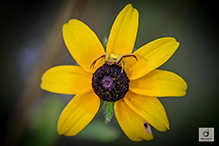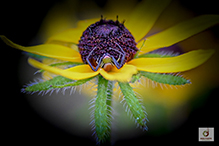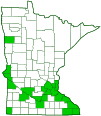white-banded crab spider
(Misumenoides formosipes)
Conservation • Description • Habitat • Biology • Distribution • Taxonomy
|
|
||||||||||||||
Description |
White-banded crab spider is a small to medium-sized spider. It occurs in the United States, Mexico, and Ontario Canada. It is found from late July to late September in prairies, fields, and woodlands. The female is 3⁄16″ to 7⁄16″ (5.0 to 11.3 mm) in length, not including the legs. The male is much smaller, ⅛″ (2.5 to 3.2 mm) in length. The female is able to change the color of the body and legs from white to lemon yellow or dull yellowish-brown to match the color of the flower on which it appears. There is a spotted form female and an unspotted form female. The plate (carapace) covering the front part of the body (cephalothorax) is flat and as long as wide. It is light in the middle, darker on the sides. There are eight eyes arranged in two curved rows of four. There is a conspicuous white transverse ridge (carina) below the bottom row of eyes, and another usually white carina between the two rows. All of the eyes are on low raised projections (tubercles). In the front row all four eyes are about the same size. In the back row the posterior lateral eyes (PLE) are directed sideways and backwards at the ends of the carina. They are not visible when the spider is viewed from the front and a little above. The area between the eyes, not including the carina, is sometimes reddish. On spotted form females there is sometimes a reddish stripe on each side of the carapace extending from the PLE almost to the rear margin. The jaws (chelicerae) are small and have no teeth. The abdomen is large, broadly oval, widest near the rear, and somewhat flattened when viewed from the side. There are no erect hairs (setae) on the upper surface. Spotted females have two rows of reddish-brown spots in the shape of an inverted V on the front half. They sometimes also have a stripe on the sides of the front half. Unspotted females lack the dark markings but are often slightly darker in these areas. The legs match the carapace in color. The front two pairs of legs are thicker and much longer than the others, and are normally held out and forward, like a crab. This is the feature that gives the family Thomisidae its common name. There is a pair of minute claws at the end of each leg, but these are not visible without magnification. Males are darker overall and shiny. The front two pairs of legs are red, brown, or black. The rear legs are the same color as the carapace. |
Size |
Female Body Length: 3⁄16″ to 7⁄16″ (5.0 to 11.3 mm) Male Body Length: ⅛″ (2.5 to 3.2 mm) |
Web |
Crab spiders do not make webs. |
Similar Species |
Habitat |
Prairies, fields, and woodlands |
Biology |
Season |
Late July to late September |
Behavior |
When the legs are held out to the side the spider is able to walk forward, backward, or sideways (laterigrade). When hunting, the spider will lie on a flower, often for hours, waiting in ambush for prey. It can change color to match the flower on which it is hunting. The color change takes from three to nine days to complete. The female does not build webs, snares, or retreats. She deposits an egg sac on nearby foliage guards it until she dies. |
Life Cycle |
|
Food |
Any creature it can catch, often larger than itself. |
Distribution |
||
|
Sources |
|
| 5/2/2024 | ||
Occurrence |
||
|
||
Taxonomy |
|
Class |
|
Order |
|
Suborder |
Araneomorphae (Typical Spiders) |
Infraorder |
Entelegynae |
Superfamily |
Thomisoidea (crab and running crab spiders) |
Family |
Thomisidae (crab spiders) |
| Subfamily | Thomisinae |
| Tribe | Misumenini |
Genus |
Misumenoides |
Subordinate Taxa |
|
|
|
Synonyms |
|
Misumenoides formocipes (misspelling) Thomisus formosipes |
|
Common Names |
|
white-banded crab spider |
|
Glossary
Carapace
The hard, upper (dorsal), shell-like covering (exoskeleton) of the body or at least the thorax of many arthropods and of turtles and tortoises. On crustaceans, it covers the cephalothorax. On spiders, the top of the cephalothorax made from a series of fused sclerites.
Carina
An elevated keel or ridge.
Cephalothorax
The front part of the body of various arthropods, composed of the head region and the thoracic area fused together. Eyes, legs, and antennae are attached to this part.
Chelicerae
The pair of stout mouthparts, corresponding to jaws, in arachnids and other arthropods in the subphylum Chelicerata.
Seta
A stiff, hair-like process on the outer surface of an organism. In Lepidoptera: A usually rigid bristle- or hair-like outgrowth used to sense touch. In mosses: The stalk supporting a spore-bearing capsule and supplying it with nutrients. Plural: setae.
Tubercle
On plants and animals: a small, rounded, raised projection on the surface. On insects and spiders: a low, small, usually rounded, knob-like projection. On slugs: raised areas of skin between grooves covering the body.
Visitor Photos |
||
Share your photo of this arachnid. |
||
This button not working for you? |
||
Mike Poeppe |
||
 |
 |
|
 |
 |
|
Dan W. Andree |
||
White-banded Crab Spider Feeding while also trying to... get a small fly off its back. It used one of its legs reaching back to try coax the fly off its back. I think the spider is feeding on some kind of stink bug. Interesting what goes on sometimes in the insect world. |
 |
|
I filmed a segment of the event to see just what was going on. The crab spider eventually ended up using one of its other legs on the opposite side of the one it has trying to reach the fly and did get it off its back. All taking place on a blanket flower on a prairie preserve in Norman Co. Mn. June 2024. |
||
Possibly a White-banded Crab Spider?? It was pretty much mostly all white. Seen it at the Twin Valley Prairie on 7-13-23 … It tried to catch a Great Spangled Fritillary twice but wasn’t successful. It did eventually catch some type of fly insect. I filmed it trying to latch on to the Great Spangled Fritillary twice and it was the same butterfly just a few minutes apart. |
 |
|
I could tell because it had a small area on one wing missing. This white spider was a little bigger than the white-banded crab spider that tried to capture the western honey bee in a past season. |
||
 |
 |
|
Another White-banded Crab Spider.... Neat little spider. |
||
Crab Spider Trying to Capture a Bee... This bee landed on an almost white wild rose blossom and the crab spider tried to grab it but the bee did get away. Interesting how crab spiders can change color to blend in. |
|
|
|
||
|
||
|
||
White-banded crab spider... White-banded crab spiders seem to be less common in areas where I have come across crab spiders in general. I see more Northern and Goldenrod and only came across the one White-banded. Yet even though it was windy that day the interaction of the spider with the Western honey bee is one of my favorite video segments. Also I was fortunate to have my external mic and wind muff on so you can see and hear it is quite windy but the wind noise is muffled and easy to listen to. Also the imagery though I had to manually focus turned out clear and focused. I have checked other times for any white-banded crab spider but haven’t seen any more but regularly come across other species. It kind of reminded me of a little white octopus trying to catch that bee.🙂 |
 |
|
Alfredo Colon |
||
 |
||
 |
 |
|
Random Citizen |
||
 |
 |
|
 |
 |
|
 |
 |
|
 |
 |
|
Babette Kis |
||
Misumenoides formosipes, whitebanded crab spider, on Solidago canadensis, Canada goldenrod, leaf |
||
 |
 |
|
MinnesotaSeasons.com Photos |
||
|
||
|
||

Slideshows |
|

Visitor Videos |
||
Share your video of this arachnid. |
||
This button not working for you? |
||
Random Citizen |
white banded crab spider 01 |
About
white-banded crab spider (Misumenoides formosipes) |
Dan W. Andree |
#"Western Honey Bee & White-banded Crab Spider" filmed by Dan W Andree |
About
A Western Honey Bee & White-banded Crab Spider encounter each other on a pale almost white wild rose blossom on a Minnesota prairie. The White-banded Crab spider is trying to capture the Western Honey Bee...It was really windy that day. The video shows the encounter in regular and slow-motion. Hope you enjoy it. |
Other Videos |
||
CRAB SPIDER with PAINTED LADY Misumenoides formosipes |
About
Oct 16, 2017 Misumenoides formosipes WHITE BANDED CRAB SPIDER with PAINTED LADY (Vanessa carduii) Mark Twain NF, MO 9/7/2012. |
Capital Naturalist: White-Banded Crab Spider Eats Bumblebee |
About
Sep 18, 2018 A White-Banded Crab Spider, one of the goldenrod crab spiders, is hidden away eating a bumblebee. |
Crab spider crawling / foraging | White banded |
About
Oct 31, 2020 Crab spider crawling / foraging | White banded, Misumenoides formosipes | poisonous | body, large | female | hunting prey: pollinators on flowers | Facts, Habitat, Behavior | HD video | Arthropod, Animal, Wildlife, Nature | #gotrails, #spider, #spiders, #arthropod, #CrabSpider |
White-banded Crab Spider (Thomisidae: Misumenoides) on Leaf |
About
May 27, 2010 Photographed at the Rydell NWR, Minnesota (27 May 2010). |

Visitor Sightings |
||
Report a sighting of this arachnid. |
||
This button not working for you? |
||
Mike Poeppe |
Location: Houston, MN |
 |
| Babette Kis 9/6/2022 |
Location: Barnes Prairie, Racine County, WI Misumenoides formosipes, whitebanded crab spider, on Solidago canadensis, Canada goldenrod, leaf |
| Alfredo Colon 8/29/2022 |
Location: Albany, NY |
 |
| Mike Poeppe 7/21/2022 |
Location: near Houston, MN |
| Random Citizen 6/30/2019 |
Location: middle Tennessee |
MinnesotaSeasons.com Sightings |
||
|

Created: 7/8/2022 Last Updated: © MinnesotaSeasons.com. All rights reserved. |







